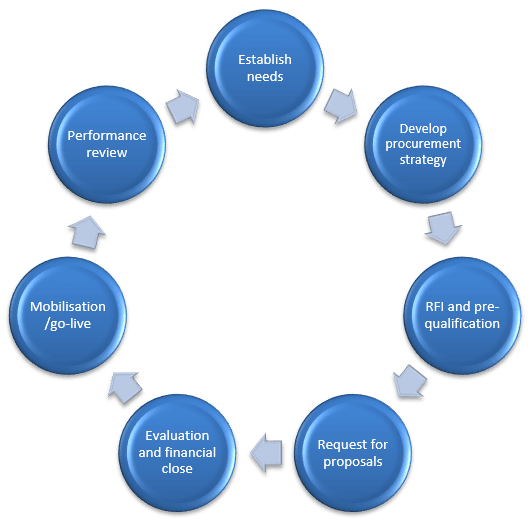Procurement of facility-related services (BS 8572)
Procurement is a key process within facilities management. The publication of a standard on procurement brings clarity and consistency to an area that has for long been neglected. Too often, decisions on the provision of services – security, waste management, cleaning, maintenance, even IT and catering – have been based on an incomplete understanding of the work involved. That can now be all in the past.
Applicability and scope
BS 8572 Procurement of facility-related services – Code of practice provides clients/owners, operators, tenants, facility managers and property managers with guidance and recommendations for the procurement of a broad range of services that are required to support the physical assets making up a facility and the needs of users of that facility. It covers both new and existing facilities and is applicable to organisations facing re-tendering of facility-related services as well as those entering directly into the later stages of the procurement process, notably mobilisation and performance review.
One of the key features of the standard is its comprehensive checklist. This has been designed to help focus attention on what needs to be done to ensure that procurement is undertaken in accordance with current best practice. As a standard, its place is to recommend appropriate practices and provide a baseline against which performance, in compliance with it, can be measured. The standard considers all stages in procurement from aligning with the client’s/owner’s business needs, through strategy development and prequalification of service providers, to tenders, contract award, mobilisation and performance review. Its recommendations are supported by explanatory notes, so users of the standard will not be left wondering what they have to do to achieve best practice and to comply with the standard.
The standard is fundamentally about outsourced services and assumes that the client’s/owner’s facilities management strategy indicates outsourcing to be an appropriate means for delivering services. Even so, for those who retain an in-house team for direct delivery of services the standard provides valuable guidance to ensure that the most appropriate outcomes are achieved in terms of best value for money and end-user satisfaction.

One of the drivers for the standard was the dearth of up-to-date guidance on procurement in facilities management. There is plenty of guidance on procurement in general and for construction-related services in particular. But facilities management is not construction. The context for service delivery could not be more different. The experience of clients/owners in successfully procuring facility-related services was taken into account in the drafting to enable principles of current best practice and compliance with various duties and obligations to be woven into the clauses. The standard is invaluable in providing an objective basis for benchmarking performance and costs, as well as encouraging a consistent way of working to emerge.
Weighing the benefits
The standard confronts a number of challenges head-on, including planning for procurement, aligning service delivery with core business needs, stakeholder engagement, risk and opportunities, option evaluation and performance measurement. There is no shortage of detailed treatment as users of the guide are taken through the various steps that are intended to provide a clear and auditable approach to procurement. The aim has been to be as comprehensive as possible in outlining the approach so that there should be little need to refer to other guidance in the subject. In fact, one of the drivers for the standard was the lack of authoritative guidance and for which a number of major clients/owners had been searching for something that could be used with all service providers.
In drafting the standard, it was clear clients/owners and service providers required clarity in areas such as prequalification and the evaluation of tenders (or proposals), and so the standard deals with them thoroughly and transparently. Moreover, it affords the flexibility required to accommodate the needs of a wide spectrum of users. The standard can be thought of as a framework within which clients/owners can design the detail of their procurement to suit their organisational requirements, as well as their operational needs, with confidence that the underlying process is joined up.
The benefits of using the standard can be summarised as follows.
Consistent way of working – a roadmap for successful procurement.
Confidence that services are defined in accordance with needs.
Transparency in operating competitive tendering.
Rigorous evaluation of service providers prior to tendering.
Thoroughness in the evaluation of tenders/proposals.
Comprehensiveness in preparations for initial service delivery.
Appropriate levels of performance review – feedback on effectiveness.
Looking forward
For clients/owners and their facilities managers defining service requirements for the first time, the standard offers a reliable basis for organising their facilities management. For those who are seasoned in the entire procurement process, the standard offers a baseline against which to audit procedures against a recognised guide to current best practice. With the standard in the hands of service providers, there is now an effective means for two-way communication to ensure that everyone is on the same page.
The procurement of facility-related services is an industry in itself and not without inefficiency and waste. In the move towards a low carbon economy, the importance of maintaining and sustaining facilities is obvious. Equally so is the means for ensuring that service delivery matches service need and that any waste in the process is eliminated. A procurement process that is in-line with this standard will provide all parties with an objective basis for measuring performance, trends and improvement. Whilst it is not possible to quote likely savings from the greater efficiency that the standard will bring, clients/owners and their facilities managers will be able to do so once they have begun to use it.
In summary
The main sections in the standard cover terms, definitions and abbreviations; primary processes; establishing needs; developing a procurement strategy; requests for information (RFIs) and pre-qualification; requests for proposals (RFPs); evaluation and commercial/financial close; mobilisation/go-live; and performance review.
BS 8572:2018 is available from the BSI bookshop.
